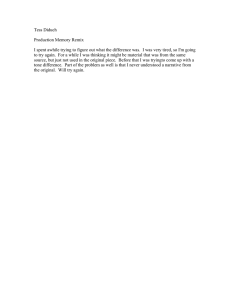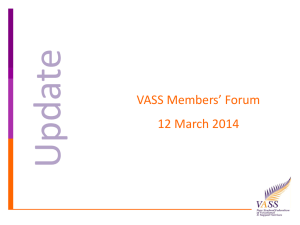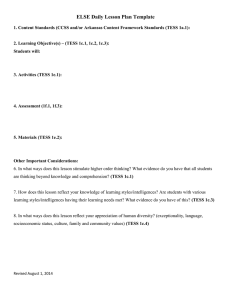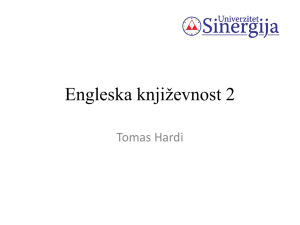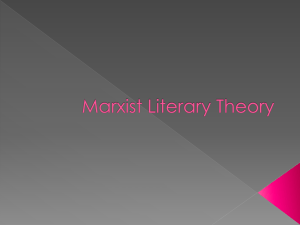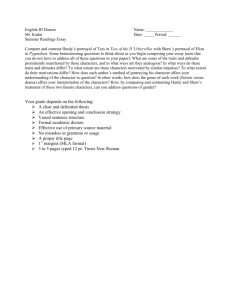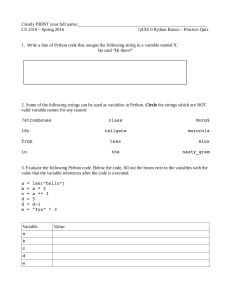UCA-MAT-Lesson-Plan-Analysis-Guide for MAT
advertisement
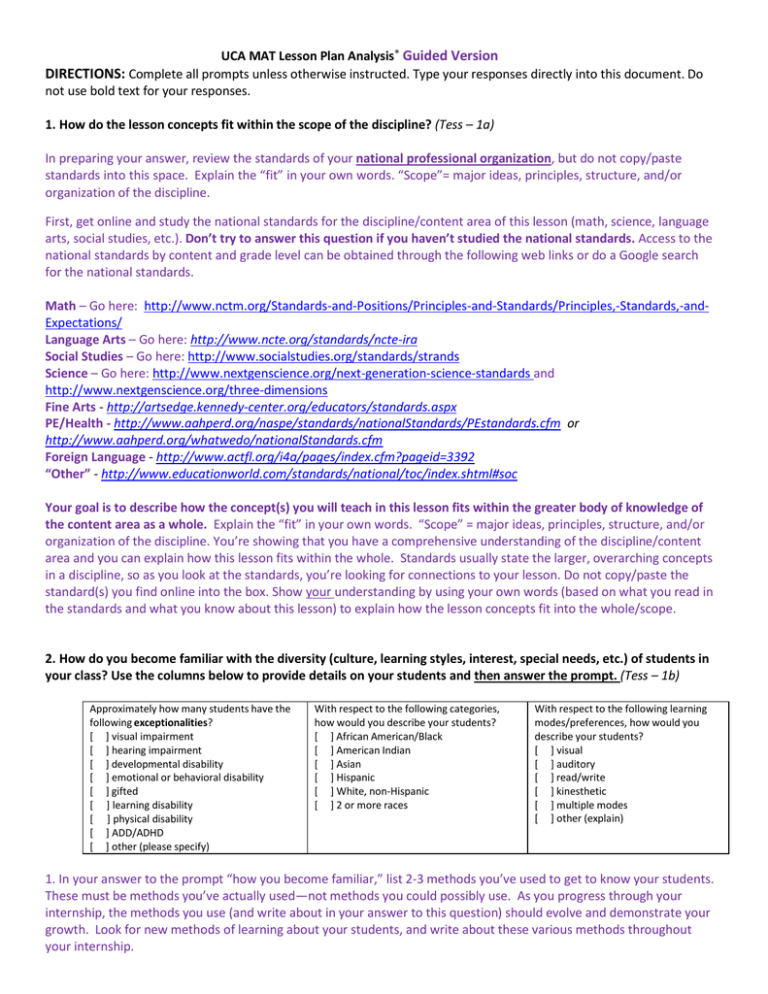
UCA MAT Lesson Plan Analysis Guided Version DIRECTIONS: Complete all prompts unless otherwise instructed. Type your responses directly into this document. Do not use bold text for your responses. 1. How do the lesson concepts fit within the scope of the discipline? (Tess – 1a) In preparing your answer, review the standards of your national professional organization, but do not copy/paste standards into this space. Explain the “fit” in your own words. “Scope”= major ideas, principles, structure, and/or organization of the discipline. First, get online and study the national standards for the discipline/content area of this lesson (math, science, language arts, social studies, etc.). Don’t try to answer this question if you haven’t studied the national standards. Access to the national standards by content and grade level can be obtained through the following web links or do a Google search for the national standards. Math – Go here: http://www.nctm.org/Standards-and-Positions/Principles-and-Standards/Principles,-Standards,-andExpectations/ Language Arts – Go here: http://www.ncte.org/standards/ncte-ira Social Studies – Go here: http://www.socialstudies.org/standards/strands Science – Go here: http://www.nextgenscience.org/next-generation-science-standards and http://www.nextgenscience.org/three-dimensions Fine Arts - http://artsedge.kennedy-center.org/educators/standards.aspx PE/Health - http://www.aahperd.org/naspe/standards/nationalStandards/PEstandards.cfm or http://www.aahperd.org/whatwedo/nationalStandards.cfm Foreign Language - http://www.actfl.org/i4a/pages/index.cfm?pageid=3392 “Other” - http://www.educationworld.com/standards/national/toc/index.shtml#soc Your goal is to describe how the concept(s) you will teach in this lesson fits within the greater body of knowledge of the content area as a whole. Explain the “fit” in your own words. “Scope” = major ideas, principles, structure, and/or organization of the discipline. You’re showing that you have a comprehensive understanding of the discipline/content area and you can explain how this lesson fits within the whole. Standards usually state the larger, overarching concepts in a discipline, so as you look at the standards, you’re looking for connections to your lesson. Do not copy/paste the standard(s) you find online into the box. Show your understanding by using your own words (based on what you read in the standards and what you know about this lesson) to explain how the lesson concepts fit into the whole/scope. 2. How do you become familiar with the diversity (culture, learning styles, interest, special needs, etc.) of students in your class? Use the columns below to provide details on your students and then answer the prompt. (Tess – 1b) Approximately how many students have the following exceptionalities? [ ] visual impairment [ ] hearing impairment [ ] developmental disability [ ] emotional or behavioral disability [ ] gifted [ ] learning disability [ ] physical disability [ ] ADD/ADHD [ ] other (please specify) With respect to the following categories, how would you describe your students? [ ] African American/Black [ ] American Indian [ ] Asian [ ] Hispanic [ ] White, non-Hispanic [ ] 2 or more races With respect to the following learning modes/preferences, how would you describe your students? [ ] visual [ ] auditory [ ] read/write [ ] kinesthetic [ ] multiple modes [ ] other (explain) 1. In your answer to the prompt “how you become familiar,” list 2-3 methods you’ve used to get to know your students. These must be methods you’ve actually used—not methods you could possibly use. As you progress through your internship, the methods you use (and write about in your answer to this question) should evolve and demonstrate your growth. Look for new methods of learning about your students, and write about these various methods throughout your internship. Adapted from http://www.arkansased.org/divisions/human-resources-educator-effectiveness-and-licensure/office-of-educatoreffectiveness/teacher-evaluation-system/tess-evaluation-forms 2. In addition to listing the 2-3 methods, describe two specific examples of your students’ knowledge, experiences, skills, developmental levels, interests, motivation to learn, learning preferences/modes, and/or cultural experiences that you learned about from methods you listed. Write about two specific students. Write about what you know about these students and how you learned this information based on methods you listed. 3. How do you use knowledge of the diversity in your classroom in planning instruction for students to be successful in reaching the learning goal(s) of the lesson? (Tess – 1b) Using the same students you wrote about in #2, describe how you’ve used what you know about the students in your instructional plan for this lesson in order to help those specific students better reach the learning goals of this lesson. Include information about the class in general and how you adjust your plans to accommodate student diversity. Demonstrate your understanding of concepts, principles, theories, and research about young adolescent development through your answer. 4. How does your lesson objective connect to prior lessons and future learning expectations? (Tess – 1c) The closer you can connect this lesson to what they have learned recently in your class and what they will be learning in your class in the near future, the better. “Prior lessons” does not mean months ago or in previous grades. It means the day before, the week before, or the previous unit of study. Be specific about when and what students learned in prior lessons that connects to this lesson’s objective(s). “Future learning expectations” does not mean the next year, future years, in college, or in life. It means the learning expectations of the next day, the next week, or the next unit of study. Be specific about when the students will be learning the future learning expectation and how it connects to this lesson’s objective(s). Note that the prompt is “HOW does your lesson objective connect…” Thus, you should EXPLAIN, not just list what they’ve just learned or will be learning. EXPLAIN the connections. Show your thinking. Avoid these kinds of answers: “My students have never studied this before, so there’s no past connection.” “Past learning includes C.4.1.3 – Discuss the roles of people in families and schools who hold positions of authority.” (This answer only lists the connection. It lacks explanation.) “Future learning will include C.4.1.3 – Discuss the roles of people in families and schools who hold positions of authority.” (No explanation.) “Students will need to know this information next year.” (Too general.) "This information will help students in their future learning." (Too general.) “It will also help them in future concepts such as algebra, trigonometry, and calculus as they progress with their education” (Still too broad. Focus the connection.) 5. What do you want students to know and be able to do as a result of this lesson? (Tess – 1c) Explain the lesson objectives in your own words. 6. What resources will you utilize to enhance this lesson? (Tess – 1d) Include a list of the materials and resources you’ll use during the lesson. 7. How will these instructional resources help you achieve the learning goals for the lesson? (Tess – 1d) Elaborate your ideas. Show your critical reasoning skills. Demonstrate your understanding of young adolescent development. First, explain how your materials/ instructional resource choices are aligned with the specific objectives you named for this lesson. Show that your material/resource choices are purposeful and were made with the objectives in mind. Why are the materials/resources you’ve planned effective choices for teaching/learning [fill in your objectives]? Use the language of your objectives in your answer, rather than generic phrases like “the subject” or “the content” or “the lesson.” Be specific. Address each material/resource and its purpose in this lesson. 8. Describe your method/strategy/approach to the lesson and explain why you made this choice. (Tess – 1a, 1e) Elaborate your ideas. Show your critical reasoning skills. Demonstrate your understanding of young adolescent development. First, explain how your method/strategy/approach is aligned with the specific objectives you named for this lesson. Show that your choices are purposeful and were made with the objectives in mind. Why are the methods you’ve planned effective choices for teaching/learning [fill in your objectives]? Use the language of your objectives in your answer, rather than generic phrases like “the subject” or “the content” or “the lesson.” Be specific. Address each method. Avoid answers that purely refer to classroom management reasoning. “I’ve chosen the method to optimize student behavior and prevent chaos. These kids get out of hand quickly.” 9. Describe the structure of your lesson. How do you use the materials, methods, and activities to differentiate instruction for students to achieve the learning outcomes? (Tess – 1e) Elaborate your ideas. Show your critical reasoning skills. Demonstrate your understanding of young adolescent development. Explain how your materials, methods, and activities choices are appropriate for these specific students who are involved in this lesson. Make references to your students’ learning styles/preferences; individual needs; physical, cognitive, and/or social/emotional development; unique experiences; gender, cultural, and/or ethnic differences; and physical, emotional, behavioral, or learning differences. Explain how the materials, methods, and activities you’ve chosen are appropriate for teaching these students based on their needs to meet the lesson’s objective(s). Be specific 10. How will you actively engage ALL students in the learning process? (Tess – 1e) Elaborate your ideas. Show your critical reasoning skills. Demonstrate your understanding of young adolescent development. Notice the emphasis on ALL, as in different kinds of learners. Describe the parts of your lesson you’ve planned to specifically engage all middle level learners. Show your understanding of young adolescent development and developmentally responsive decision making. 11. Describe and explain the various groupings of students throughout the lesson. (Tess – 1e) Elaborate your ideas. Show your critical reasoning skills. Demonstrate your understanding of young adolescent development. Describe how you’ll group students. Example: “Students will work in pairs for the activities. Students will work individually for the assessment.” Also, explain how your grouping choices are aligned with the specific objectives you named for this lesson. Show that your choices are purposeful and were made with the objectives in mind. Why are the grouping choices you made effective choices for teaching/learning [fill in your objectives]? Use the language of your objectives in your answer, rather than generic phrases like “the subject” or “the content” or “the lesson.” Be specific. Second, explain how your grouping choices are appropriate for these specific students who are involved in this lesson. Make references to your students’ learning styles/preferences; individual needs; physical, cognitive, and/or social/emotional development; unique experiences; gender, cultural, and/or ethnic differences; and physical, emotional, behavioral, or learning differences. Explain how the grouping choices you’ve made are appropriate for teaching these students based on their needs. Be specific. Avoid answers that purely refer to classroom management reasoning, like “Students will work individually because these students get rowdy easily and working alone at their desks is the only way to manage their behavior and keep them from getting out of hand.” 12. What methods of assessment (formative/summative) will you use to determine whether ALL students have mastered the learning goals? (Tess – 1f) Describe each of your assessments. Indicate if an assessment is formative or summative. Explain how each assessment is aligned to one or more of your objectives and the activities you’ve planned for students. Assessment should occur throughout your lesson. You should have at least 2-3 planned strategies for checking understanding during the lesson. These need to go beyond just asking a question to the whole group and calling on the hands. Or asking students to “think about the answer” and then calling on one or two students. These two methods provide very little usable information about how well ALL students are meeting the objectives. It’s not that you shouldn’t ever use those two methods to ask questions, but they are not effective methods of assessing students’ levels of understanding. A more effective and informative method might look like this: ask all students to answer a question individually on paper after an activity. The question should be closely aligned to an objective of the lesson and to the content of the activity students just completed. As students work individually on their own paper to answer the question (that you’ve displayed on the screen and read aloud), you walk around and check some answers. When everyone has had a chance to answer on paper, ask them to share their answer with a partner. While they share you walk around and listen to some partners. Finally, you call on a few students to share with the whole group. (This is called Think-Write-Pair-Share.) A second method could be an exit ticket. It looks like this: at the end of the lesson, ask students to answer a few questions based on the day’s objectives before they leave as a show of their learning. The questions are closely aligned to the objectives and the activities of the lesson. You take up their answers so you have some data on each individual’s achievement level. This is a systematic assessment of ALL students. It doesn’t have to be for points. If you have a few minutes left until the bell, take up the papers and then ask some students to share their answers while you point to the objectives on the board to emphasize what students have learned. There are lots of creative ways to quickly assess student learning. Google it. 13. How will you use assessment data to plan for future instruction? (Tess – 1f) You must describe how you will use the results of your assessment for planning instruction. You must address what you will do for those who DO meet the lesson objectives AND what you plan to do for those who DO NOT meet the objectives. You must be specific about your plans. Avoid this kind of generalized answer: “I’ll work on the objectives more with those who don’t meet them and for those who do, I’ll move them forward.” or “I’ll use the results to help me plan future lessons.” An effective answer will be specific about your plans for each group—those who DO meet the objectives and those who DO NOT. Example: "For my students who are able to successfully revise the verbs in their paragraphs with stronger, more active verbs, I will move to a mini-lesson on the use of adjectives to improve style. For students who need improvement in their revision of verbs in their paragraphs, I will meet with them in small groups and together we'll revise verbs in sentences from my model paragraph until I feel they have better grasped the concept." 14. Is there anything else I need to know about the lesson? 15. Is there anything else I need to know about the classroom environment?
